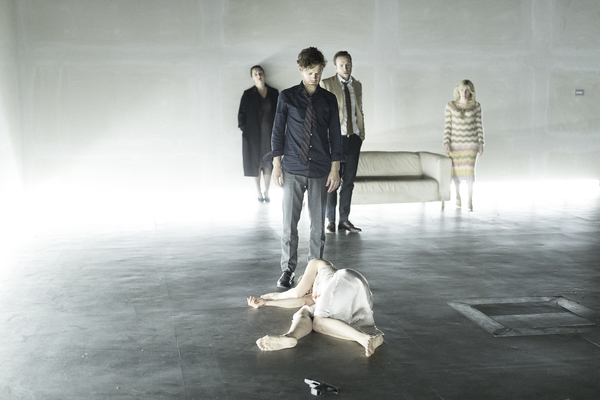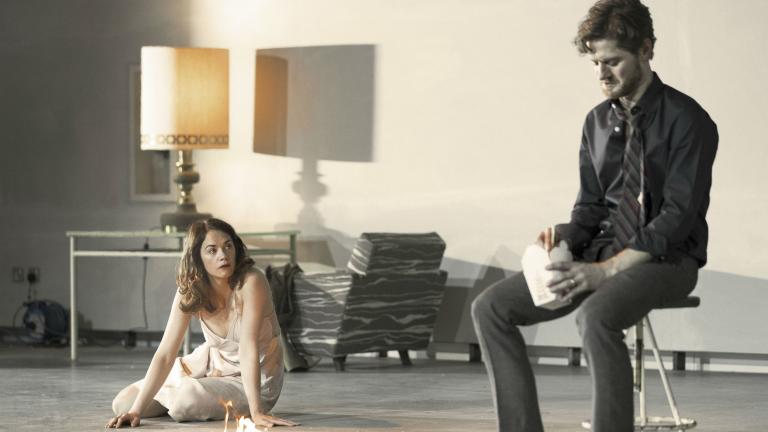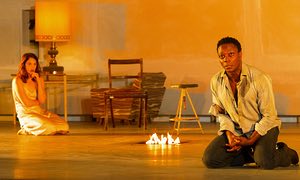
Closing moments of the play
Friends,
It’s more than possible if you live near a theater or movie-house taking in the HD films sent to the US from several different theaters in London (the Old Vic, the National Theater, the Barbican) and elsewhere (Stratford-upon-Avon), you’ll see this Ibsen’s Hedda Gabler as directed by Ivo Van Hove, setting sand lighting Jan Versweyveld, advertised. Suddenly this old play, a semi-museum piece becomes astonishingly good and fresh. As I left I felt that even the best TV mini-series (the on-going Handmaid’s Tale makes a good contrast because both are feminist) can’t be as pander free as this. This is subtler and more riveting for that, for me especially over the precious manuscript and hope for recreation.
Not that the players were not made to strain to some extent for shock value — Dr Brack (Rafe Spall, the powerful actor-son of Timothy) has a soda can which spits blood and after Hedda (Ruth Wilson. remarkably feelingful face and body) has driven Luvborg (Chukwudi Iwuji) from the room with a pistol to kill himself, Brack keeps pouring it on Hedda, here, there, everywhere eon her body, slip, across her face. It seems we are inured and to hit us strongly all public art must compete against spectacles. With this proviso, I felt I understood the play for the first time; it really reached me as it had not done before. Of central importance is the colloquial translation by Patrick Marber — with precise enough words too. It was as if I’d taken in the speeches for the first time viscerally. I wish I could read the script and then re-see the play (also compare it with older translations).

Hedda and Tesman
It was acted in a wide space that looked like a loft; what was so striking was the acting out of the lines physically and with gestures. The simple stark images; so a fire in a grate in the middle of the room before Hedda burns Lovburg’s manuscript.

A piano. One couch which Tesman (Kyle Soller, extraordinary presence in Poldark and made a minor role in Hollow Crown, major, unforgettable) and Hedda sit on, is also a bed. Hedda (Ruth Wilson, a brilliant actress, strong and feelingful) had a slip on and at first a robe — like Maggie in Cat on a Hot Tin Roof.

Hedda listening to Mrs Elvsted
Mrs Elvsted played by Sinead Matthews (also remarkable), in a tight knitted garment and very high heels. A story of how she took the husband of the woman she was working for as governess (a reverse of Waterford paradigm), the wife died, and then when she found herself saddled with him and his children she fled with a passing tutor, Luvborg and has found an occupation in life by living by his side and catering to him, especially his writing project. Lovborg, an actor with less British credentials but spotted by the national theater. (Iwuji “trained in Wisconsin said the moderator more than once in a kind of inverse snobbery — one has to endure a hype but brief preface). All in stark simple outfits: ordinary trousers (black, jeans) and shirts. Only Brack had something which made him feel more like an authority figure, Tesman an intellectual.

Hedda and Brack
They conveyed how Hedda became an evil force through never giving her any outlet; how twisted and manic she was, how Brack bullies and terrifies her and she kills herself partly because at the end she is in his power, while Tesman finds a new lease on life by taking fragments and notes Lovburg’s mistress has in her deep bag, enough to recreate the book with, Hedda will be left to the intense presence of Brack. It is deeply feminist even though the two key female roles are women with less than admirable traits, and are not beaten or attacked directly. There is a silent maid in black, sitting gazing, watching, sometimes smoking, ready to hand with things needed (Eva Magyar) referred to as an aunt, and a very tall housekeeper (Kate Duchene) with choral-like utterances who in another production would be taking care of the children.
On Trollope19thCStudies, we read these classic 19th century novels and most of them show couples who are basically living very conventionally — occasionally illegitimacy is seen, off stage a mistress. What’s striking about all Ibsen’s 19th century plays is he shows this is a false veneer of how individuals actually lived. In the version of the Richardson Pamela story by him the servant was driven away and her baby taken from her long before the play began. A Doll’s House is the opposite of what Dickens wants us to accept as a good contented ending of Our Mutual Friend. It is a very 19th century work too — that’s what might be forgotten as people watch and then they go back to their older novels and not connect.
A couple of good reviews: Lyttelton from The Guardian; Dominic Cavendish says it’s one of the great productions of the year; Alan Franks of LondonTheater1.com: a crew of people seeking personal fulfillment with no compromises turn self-destructive and destroy what they can of one another because they do not reign in their anarchic sexuality and emotional cravings.
There are many quieter scenes; here is one:
Ellen

One thought on “Hedda Gabler from the National Theater in London — an HD film”